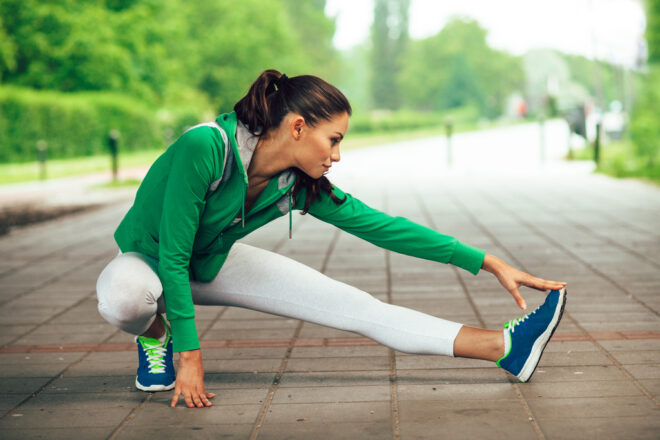Daily exercise can help you stay healthy and feel great. It can energize you and tone your body so that you look your best.
Studies show that regular exercise decreases the risk of cardiovascular disease and mortality. It can also lower blood pressure and increase insulin sensitivity.
Exercising regularly can prevent chronic diseases like diabetes, obesity, hypertension, osteoporosis, depression, and cancer. The more you exercise, the greater the impact on your health.
Following a daily workout consistently doesn’t have to be daunting. Choosing the right exercises and knowing how hard to push yourself can help you achieve results without feeling that your daily exercise routine is a drag.
Read on to discover some of the best exercises to do every day as part of a fun and effective beginner workout routine.
In This Article
In This Article:
7 Simple but Effective Exercises To Do Everyday
Here are 7 exercises to do everyday for better overall fitness. Together, these bodyweight exercises can provide a full body workout at home with minimal equipment.
Squat
Squats strengthen your quads, lower back, and core. A 2021 study of 16 older adults found that both shallow and deep squats performed at home improved lower limb function.
The participants in the study did four sets of squats consisting of 35 repetitions per set 3 days a week for 12 weeks.
To do a squat with perfect form:
1. Stand with feet slightly wider than shoulder width and arms hanging at your sides.
2. Hold your chin and chest up, brace your core, and bend your knees into a sitting position even as you push your hips back.
3. Lower yourself slowly toward the floor until your thighs are parallel to it, and bring your arms forward. Don’t bend your knees in or out but keep them facing forward.
4. Hold the position for a second and then return to the starting position with a controlled movement to complete a rep.
5. Do 3 sets of 15 reps each.
Lunges
Doing lunges regularly increases hip mobility and strengthens the muscles of your lower body. It also engages your core. If you want stronger, more toned quadriceps, hamstrings, and glutes, add lunges to your daily workout routine.
1. Stand with your feet at shoulder width and arms hanging at your sides.
2. Step forward with one leg, bending your knee until your thigh is parallel to the floor.
3. Push up off your foot to return to the initial position.
4. Repeat with the other leg to complete a rep.
5. Do 3 sets of 15 reps each.
Planks
The plank exercise activates core muscles without straining the lumbar vertebra. To a lesser extent, planks also engage muscles in your back and shoulders.
1. Place your elbows and toes on the floor and bring your hands together so that both your forearms are resting on the floor.
2. Hold your back straight and engage your core, glutes, quads, shoulders, and triceps.
3. Tuck your chin and focus your gaze in front of you.
4. Hold the position and tension and breathe deeply.
5. Stay in the plank position for 30 seconds. With time, you can increase the duration of your planks.
Good to know: Maintaining a plank position for over 2 minutes is above average. Keeping a plank for 6 minutes or longer is excellent.
Push-ups
Push-ups work your chest, triceps, and shoulders. They also engage your core. As one of the most popular exercises, push-ups are easy to incorporate into most workouts.
1. Place your hands and toes on the floor, hold your back straight, and engage your core.
2. Lower your body slowly, bending your elbows until you touch the floor with your chest.
3. Lift yourself back to the initial position by extending your elbows to complete a rep.
4. Start with 3 sets of 10 reps each.
Good to know: A study of 23 individuals found that push-ups with the feet elevated on a box produced the most intense training load. By comparison, push-up variations with hands elevated or flexed knees are easier to perform.
Pull-ups
Pull-ups work your back, arms, and shoulders and enhance your grip strength. They are one of the more challenging exercises to do every day. But if you do them regularly, you can build tougher muscles.
To do pull-ups, you need a crossbar or branch that can bear your weight.
1. Place your hands on the bar or branch with a forward-facing grip at shoulder width.
2. Push your chest out and curve your back.
3. Breathing out, pull your body high enough so that the bar is at chest level.
4. Lower yourself slowly to the initial position as you breathe in.
5. Do 3 sets of 8 reps each with 60 seconds of rest in between sets.
Crunches
Crunches target the rectus abdominis and obliques and can help you build stronger abs. But bear in mind that to build a six-pack, mixing in other ab workouts and minding your diet are crucial.
1. Lie on the floor looking at the ceiling with knees bent. Your feet should be flat on the floor.
2. Cross your arms on your chest.
3. Using your upper back muscles, lift your shoulders off the floor.
4. Hold for two seconds at the end of the movement and then lower yourself back to the floor to complete a rep.
5. Do 3 sets of 10 to 15 reps each.
To do crunches with perfect form, keep your chin tucked as you perform the movement. You also want to squeeze your abs when you begin your upward movement and slowly lower yourself to the initial position.
It helps to place a rolled-up towel behind your head before doing crunches. This helps reduce the strain on your neck.
Burpees
Burpees may not be the easiest exercise on this list. But they work your whole body and are great as part of a high-intensity interval training workout. They can help you do a fast full-body workout at home.
1. Stand with feet at shoulder width and arms hanging at your sides.
2. Squat down, holding your hands in front of you.
3. As your hands touch the ground, kick your legs back into a plank position.
4. Do a push-up.
5. Jump with your feet back into a squat.
6. Leap up high with your arms above your head to complete a rep.
7. Do 3 sets of 8 reps each.
Tips to Maintain a Successful Workout Routine
Warming up, maintaining proper posture, and adding variety to your training plan are some of the key ways to develop an efficient workout routine.
Warm up and cool down
Get ready for your daily workout with a 10-minute warmup. More than gearing you for action, a warmup can reduce the risk of injury.
Jog in place for 5 minutes and then do some dynamic stretches like arm circles, arm swings, and hip circles.
Cooling down after your workout is just as important. You can choose between yoga, going out for a walk, or doing a few more stretches.
Make sure your posture is right
Maintaining a correct posture safeguards you from injury and ensures you perform exercises correctly.
In many cases, a correct posture means keeping your back straight, avoiding straining your neck, and not hunching your shoulders.
Follow the instructions for each type of exercise carefully to ensure your posture is always right.
If you experience back pain or suffer from an injury, refrain from training until your body recovers. Else you may make your injury worse.
Mix it up
Don’t do the same exercises day in and day out. Keep your daily workout routine fun and effective by mixing up different exercises.
Try exercise variations to challenge your body and target different muscle groups.
The list of exercises we shared with you features versatile exercises you can incorporate into most at-home workouts.
Don’t forget about cross-training like yoga. Doing yoga regularly has a host of health benefits.
It makes your body more flexible, enhances muscular strength, improves cardiovascular and respiratory function, improves sleep, and reduces stress, anxiety, and depression.
Other ways to cross-train include brisk walking, swimming, and cycling.
Follow a training plan
With a training plan, you can get the most out of every workout and stay on track as you move toward your fitness goals.
A good training plan shows you how much and how hard you have to train. It increases your workout difficulty gradually so that you keep seeing gains without risking injury.
A training plan will also include rest days so that you give your body time to recover.
Free workout plans can help you build your fitness. But for best results, follow a personalized workout plan that takes into account your age, weight, fitness level, and fitness goals.
Takeaways
Now that you know 7 exercises to do everyday, here are a few things to keep in mind:
- You can do a full-body workout at home with squats, lunges, pushups, burpees, and other exercises without special equipment.
- Always warm up and cool down after your daily workout.
- Doing a daily workout is great, but always listen to your body and rest on some days if it’s needed.
- Mix exercises, try variations, and cross-train to keep your daily exercise routine fresh and effective.
- Follow a personalized training plan for the best results.
Daily exercise can change your life. Start today!
Frequently Asked Questions
What is the best 7 day workout routine?
There is no one-size-fits-all answer to this question, as the best 7-day workout routine will vary depending on your individual fitness level, goals, and schedule. However, a general guideline is to incorporate a variety of exercises that target all major muscle groups. This could include cardio exercises like running, swimming, or biking, strength training exercises like lifting weights, and flexibility exercises like yoga or Pilates. It is also important to include rest days in your routine to allow your body to recover.
What exercise is OK to do every day?
There are a few exercises that are generally safe to do every day, such as walking, swimming, and yoga. These exercises are low-impact and gentle on your joints, making them less likely to cause injury. However, it is important to listen to your body and take rest days when you need them.
What is the best exercise for overall health?
The best exercise for overall health is a combination of cardio, strength training, and flexibility exercises. Cardio exercises help to improve your cardiovascular health, strength training exercises help to build muscle and burn calories, and flexibility exercises help to improve your range of motion and reduce the risk of injury.
What is the best 7 minute workout plan?
The 7-minute workout plan is a high-intensity interval training (HIIT) workout that consists of 12 exercises that are performed for 30 seconds each, with 10 seconds of rest between each exercise. The workout can be done at home without any equipment.
Here is a sample 7-day workout routine:
Day 1: Cardio
- 30 minutes of running, swimming, or biking
Day 2: Strength training
- Push-ups
- Squats
- Lunges
- Planks
Day 3: Cardio
- 20 minutes of running, swimming, or biking
Day 4: Rest
Day 5: Strength training
- Pull-ups
- Overhead presses
- Bicep curls
- Triceps extensions
Day 6: Cardio
- 15 minutes of running, swimming, or biking
Day 7: Flexibility
- Yoga
- Pilates
This is just a sample routine, and you may need to adjust it based on your own fitness level and goals. It is always a good idea to talk to your doctor before starting any new exercise program.
What are the benefits of doing 7 exercises every day?
There are many benefits to doing 7 exercises every day, including:
- Improved cardiovascular health: Exercise helps to strengthen the heart and improve blood circulation. This can reduce the risk of heart disease, stroke, and other health problems.
- Increased muscle mass: Exercise helps to build muscle, which can boost metabolism and help you burn more calories at rest.
- Improved flexibility: Exercise helps to increase flexibility, which can reduce the risk of injuries.
- Reduced stress: Exercise helps to reduce stress, improve mood, and improve sleep quality.
What are the risks of doing 7 exercises every day?
There are some risks to doing 7 exercises every day, including:
- Overtraining: If you do too much exercise, you can overtrain, which can lead to fatigue, injury, and illness.
- Injuries: Exercise can increase your risk of injury, especially if you are not used to exercising or if you do not warm up properly.
References:
- Guillen, A., THE ADDITIONS IN THE EXERCISES IN DAILY LIFE.
- Hewett, B.L., 2020. Exercises. In A Scholarly Edition of Samuel P. Newman’s A Practical System of Rhetoric (pp. 277-319). Brill.
- Dubbert, P.M., 2002. Physical activity and exercise: recent advances and current challenges. Journal of consulting and clinical psychology, 70(3), p.526.
- Abou Elmagd, M., 2016. Benefits, need and importance of daily exercise. Int. J. Phys. Educ. Sports Health, 3(5), pp.22-27.
- Hanh, T.N., 2008. Mindful movements: Ten exercises for well-being. Parallax Press.














